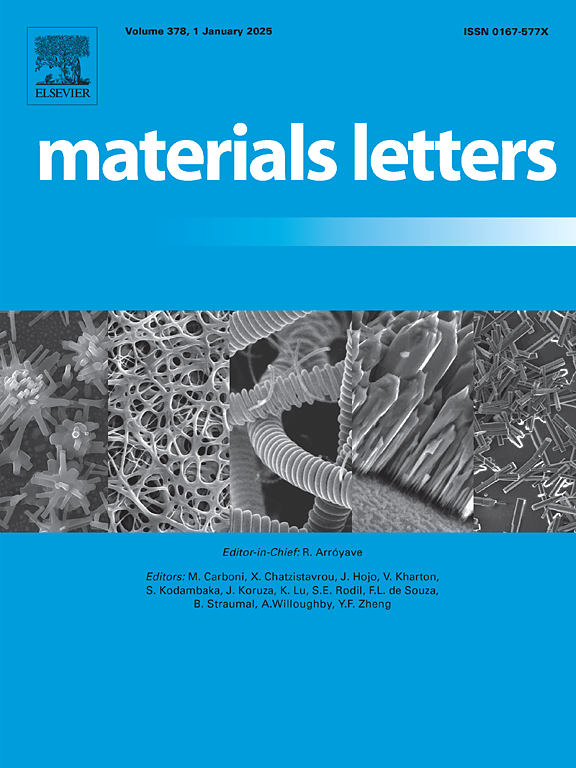可溶AZ31镁合金阳极,wo3包覆Mo阴极,用于瞬态电池持续水分解
IF 2.7
4区 材料科学
Q3 MATERIALS SCIENCE, MULTIDISCIPLINARY
引用次数: 0
摘要
在此,我们报道了一种镁合金(AZ31)-氧化钨(WO3)瞬态电池(TB)的开发,该电池采用可生物降解带作为结构支撑。该电池由镁合金阳极、WO3涂层Mo箔(WO3/Mo)阴极和海藻酸钠与磷酸盐缓冲盐水(PBS)凝胶电解质组成。充电容量为10.5 mAh/cm2,能量密度为13.96 mWh/cm2,放电电流密度为0.05 mA/cm2,开路电压为1.59 V。电池可以稳定运行8天左右,但在更高的放电率下,性能会下降3倍。它在六周内几乎完全在土壤中降解。当集成到双电极水分解系统时,电池成功地促进了电解,产生氢气和氧气,同时诱导pH值在十分钟内从中性变为碱性。这些结果突出了其在环境设置中局部pH调节的潜力,例如在石油泄漏后恢复海洋pH,同时也作为可再生氢能源的可持续来源。本文章由计算机程序翻译,如有差异,请以英文原文为准。

Dissoluble AZ31 magnesium alloy anode with WO3-coated Mo cathode for transient batteries in sustainable water splitting
Herein, we report the development of a magnesium alloy (AZ31)-tungsten oxide (WO3) transient battery (TB) utilizing biodegradable tape as structural support. The battery comprises an Mg alloy anode, a WO3-coated Mo foil (WO3/Mo) cathode, and a sodium alginate with phosphate-buffered saline (PBS) gel electrolyte. It delivers a charge capacity of 10.5 mAh/cm2, an energy density of 13.96 mWh/cm2, and an open-circuit voltage of 1.59 V at a discharge current density of 0.05 mA/cm2. The battery operates stably for ∼ 8 days, though its performance declines threefold under higher discharge rates. It degrades almost completely in soil within six weeks. When integrated into a two-electrode water-splitting system, the battery successfully facilitates electrolysis, generating hydrogen and oxygen gases while inducing a pH shift from neutral to alkaline within ten minutes. These results highlight its potential for localized pH regulation in environmental settings, such as restoring ocean pH after oil spills, while also serving as a sustainable source of renewable hydrogen energy.
求助全文
通过发布文献求助,成功后即可免费获取论文全文。
去求助
来源期刊

Materials Letters
工程技术-材料科学:综合
CiteScore
5.60
自引率
3.30%
发文量
1948
审稿时长
50 days
期刊介绍:
Materials Letters has an open access mirror journal Materials Letters: X, sharing the same aims and scope, editorial team, submission system and rigorous peer review.
Materials Letters is dedicated to publishing novel, cutting edge reports of broad interest to the materials community. The journal provides a forum for materials scientists and engineers, physicists, and chemists to rapidly communicate on the most important topics in the field of materials.
Contributions include, but are not limited to, a variety of topics such as:
• Materials - Metals and alloys, amorphous solids, ceramics, composites, polymers, semiconductors
• Applications - Structural, opto-electronic, magnetic, medical, MEMS, sensors, smart
• Characterization - Analytical, microscopy, scanning probes, nanoscopic, optical, electrical, magnetic, acoustic, spectroscopic, diffraction
• Novel Materials - Micro and nanostructures (nanowires, nanotubes, nanoparticles), nanocomposites, thin films, superlattices, quantum dots.
• Processing - Crystal growth, thin film processing, sol-gel processing, mechanical processing, assembly, nanocrystalline processing.
• Properties - Mechanical, magnetic, optical, electrical, ferroelectric, thermal, interfacial, transport, thermodynamic
• Synthesis - Quenching, solid state, solidification, solution synthesis, vapor deposition, high pressure, explosive
 求助内容:
求助内容: 应助结果提醒方式:
应助结果提醒方式:


